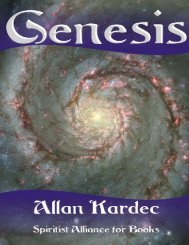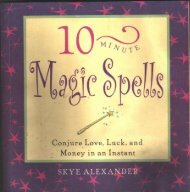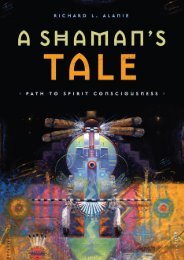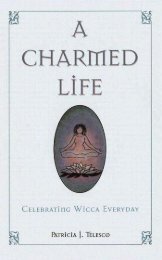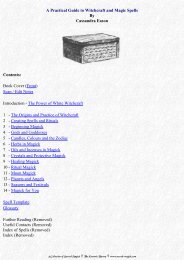- Page 3:
SPIRITUALIST PHILOSOPHY Edição es
- Page 6 and 7:
ISBN 85-7328-022-0 6ª edição (2
- Page 9 and 10:
9 TRANSLATOR'S PREFACE IN presentin
- Page 11 and 12:
11 THE SPIRITS’ BOOK Phrenologica
- Page 13 and 14:
13 THE SPIRITS’ BOOK He also foun
- Page 15 and 16:
15 THE SPIRITS’ BOOK formation to
- Page 17:
THE SPIRITS’ BOOK
- Page 21 and 22:
21 INTRODUCTION I FOR new ideas new
- Page 23 and 24:
23 THE SPIRITS’ BOOK the confusio
- Page 25 and 26:
25 THE SPIRITS’ BOOK Of the facts
- Page 27 and 28:
27 THE SPIRITS’ BOOK at an advers
- Page 29 and 30:
29 THE SPIRITS’ BOOK tedious and
- Page 31 and 32: 31 THE SPIRITS’ BOOK The replies
- Page 33 and 34: 33 THE SPIRITS’ BOOK God, and the
- Page 35 and 36: 35 THE SPIRITS’ BOOK information
- Page 37 and 38: 37 THE SPIRITS’ BOOK divergent sy
- Page 39 and 40: 39 THE SPIRITS’ BOOK assemblies,
- Page 41 and 42: 41 THE SPIRITS’ BOOK would learn
- Page 43 and 44: 43 THE SPIRITS’ BOOK millions, re
- Page 45 and 46: 45 THE SPIRITS’ BOOK selves, and
- Page 47 and 48: 47 THE SPIRITS" BOOK have the same
- Page 49 and 50: 49 THE SPIRITS’ BOOK this matter.
- Page 51 and 52: 51 THE SPIRITS’ BOOK XV There are
- Page 53 and 54: 53 THE SPIRITS’ BOOK on a rationa
- Page 55 and 56: 55 THE SPIRITS’ BOOK verging in t
- Page 57 and 58: 57 THE SPIRITS’ BOOK infallibilit
- Page 59 and 60: 59 PROLEGOMENA PHENOMENA which are
- Page 61: 61 THE SPIRITS’ BOOK "Do not allo
- Page 64 and 65: 64 ALLAN KARDEC Proofs of the Exist
- Page 66 and 67: 66 ALLAN KARDEC intelligent man, an
- Page 68 and 69: 68 CHAPTER II GENERAL ELEMENTS OF T
- Page 70 and 71: 70 ALLAN KARDEC "Spirit and matter
- Page 72 and 73: 72 ALLAN KARDEC only the result of
- Page 74 and 75: 74 CHAPTER III CREATION 1. FORMATIO
- Page 76 and 77: 76 ALLAN KARDEC glory of God? So fa
- Page 78 and 79: 78 ALLAN KARDEC suppose, the first
- Page 80 and 81: 80 ALLAN KARDEC Geology, in its stu
- Page 84 and 85: 84 ALLAN KARDEC of the universal ma
- Page 86 and 87: 86 ALLAN KARDEC Intelligence and In
- Page 88 and 89: 88 BOOK SECOND -THE SPIRIT-WORLD, O
- Page 90 and 91: 90 ALLAN KARDEC 83. Is there an end
- Page 92 and 93: 92 ALLAN KARDEC "There is a great d
- Page 94 and 95: 94 ALLAN KARDEC which they have acq
- Page 96 and 97: 96 ALLAN KARDEC progress in knowled
- Page 98 and 99: 98 ALLAN KARDEC In their conimunica
- Page 100 and 101: 100 ALLAN KARDEC They may be divide
- Page 102 and 103: 102 ALLAN KARDEC their own fault, a
- Page 104 and 105: 104 ALLAN KARDEC lowest depths of e
- Page 106 and 107: 106 ALLAN KARDEC the term, lacks th
- Page 108 and 109: 108 ALLAN KARDEC "They arrive more
- Page 110 and 111: 110 ALLAN KARDEC the word is used t
- Page 112 and 113: 112 ALLAN KARDEC Materialism 147. W
- Page 114 and 115: 114 CHAPTER III RETURN FROM THE COR
- Page 116 and 117: 116 ALLAN KARDEC to the body. The s
- Page 118 and 119: 118 ALLAN KARDEC 161. In cases of v
- Page 120 and 121: 120 CHAPTER IV PLURALITY OF EXISTEN
- Page 122 and 123: 122 ALLAN KARDEC Incarnation in Dif
- Page 124 and 125: 124 ALLAN KARDEC "They undoubtedly
- Page 126 and 127: 126 ALLAN KARDEC According to the s
- Page 128 and 129: 128 ALLAN KARDEC advance in knowled
- Page 130 and 131: 130 ALLAN KARDEC - The spirit of a
- Page 132 and 133:
132 ALLAN KARDEC of fraternity even
- Page 134 and 135:
134 ALLAN KARDEC 213. Since spirits
- Page 136 and 137:
136 ALLAN KARDEC learned. He may, d
- Page 138 and 139:
138 CHAPTER V PLURALITY OF EXISTENC
- Page 140 and 141:
140 ALLAN KARDEC to deserve a more
- Page 142 and 143:
142 ALLAN KARDEC invent Him for the
- Page 144 and 145:
144 ALLAN KARDEC had lived longer t
- Page 146 and 147:
146 ALLAN KARDEC the highest reason
- Page 148 and 149:
148 ALLAN KARDEC to St John that Je
- Page 150 and 151:
150 ALLAN KARDEC is a punishment in
- Page 152 and 153:
152 ALLAN KARDEC Transitional World
- Page 154 and 155:
154 ALLAN KARDEC The life of spirit
- Page 156 and 157:
156 ALLAN KARDEC 248. Do spirits se
- Page 158 and 159:
158 ALLAN KARDEC hut cannot exercis
- Page 160 and 161:
160 ALLAN KARDEC that the perispiri
- Page 162 and 163:
162 ALLAN KARDEC and into the futur
- Page 164 and 165:
164 ALLAN KARDEC recommence the tas
- Page 166 and 167:
166 ALLAN KARDEC volition, or is th
- Page 168 and 169:
168 ALLAN KARDEC It is with a spiri
- Page 170 and 171:
170 ALLAN KARDEC 273. Might a man b
- Page 172 and 173:
172 ALLAN KARDEC suffer themselves.
- Page 174 and 175:
174 ALLAN KARDEC 292. Do spirits ex
- Page 176 and 177:
176 ALLAN KARDEC "Perfect sympathy
- Page 178 and 179:
178 ALLAN KARDEC " Almost always th
- Page 180 and 181:
180 ALLAN KARDEC "This feeling is o
- Page 182 and 183:
182 ALLAN KARDEC - Do they feel fla
- Page 184 and 185:
184 ALLAN KARDEC 333. If a spirit f
- Page 186 and 187:
186 ALLAN KARDEC remain with him to
- Page 188 and 189:
188 ALLAN KARDEC "No; they are grad
- Page 190 and 191:
190 ALLAN KARDEC worse than himself
- Page 192 and 193:
192 ALLAN KARDEC we should be force
- Page 194 and 195:
194 ALLAN KARDEC of his organs of p
- Page 196 and 197:
196 ALLAN KARDEC "The spirit, regai
- Page 198 and 199:
198 ALLAN KARDEC "Not always; the r
- Page 200 and 201:
200 ALLAN KARDEC with fortitude, an
- Page 202 and 203:
202 ALLAN KARDEC -Might it be worse
- Page 204 and 205:
204 CHAPTER VIII EMANCIPATION OF TH
- Page 206 and 207:
206 ALLAN KARDEC pugnance, to incar
- Page 208 and 209:
208 ALLAN KARDEC he desires or of w
- Page 210 and 211:
210 ALLAN KARDEC fact of going, dur
- Page 212 and 213:
212 ALLAN KARDEC "No; they are rece
- Page 214 and 215:
214 ALLAN KARDEC he sees through hi
- Page 216 and 217:
216 ALLAN KARDEC the heat or the co
- Page 218 and 219:
218 ALLAN KARDEC from matter more e
- Page 220 and 221:
220 ALLAN KARDEC itself, so to say,
- Page 222 and 223:
222 ALLAN KARDEC he may display in
- Page 224 and 225:
224 ALLAN KARDEC character. They ge
- Page 226 and 227:
226 ALLAN KARDEC Occult Influence o
- Page 228 and 229:
228 ALLAN KARDEC 469. By what means
- Page 230 and 231:
230 ALLAN KARDEC "You can always sh
- Page 232 and 233:
232 ALLAN KARDEC sensibility of the
- Page 234 and 235:
234 ALLAN KARDEC existences; for th
- Page 236 and 237:
236 ALLAN KARDEC The doctrine of gu
- Page 238 and 239:
238 ALLAN KARDEC answer this appeal
- Page 240 and 241:
240 ALLAN KARDEC 514. Are "familiar
- Page 242 and 243:
242 ALLAN KARDEC only partial. are
- Page 244 and 245:
244 ALLAN KARDEC because it was in
- Page 246 and 247:
246 ALLAN KARDEC 533. Can spirits o
- Page 248 and 249:
248 ALLAN KARDEC 539. In the produc
- Page 250 and 251:
250 ALLAN KARDEC "Very few deaths a
- Page 252 and 253:
252 ALLAN KARDEC "Yes; there are sp
- Page 254 and 255:
254 CHAPTER X OCCUPATIONS AND MISSI
- Page 256 and 257:
256 ALLAN KARDEC be perfect, he mus
- Page 258 and 259:
258 ALLAN KARDEC "Among spirits, as
- Page 260 and 261:
260 ALLAN KARDEC than to train the
- Page 262 and 263:
262 ALLAN KARDEC sensitiveness, and
- Page 264 and 265:
264 ALLAN KARDEC ideas, while that
- Page 266 and 267:
266 ALLAN KARDEC until then, his na
- Page 268 and 269:
268 ALLAN KARDEC "The earth is not
- Page 270 and 271:
270 ALLAN KARDEC nation has its roo
- Page 272 and 273:
272 ALLAN KARDEC Some of the divine
- Page 274 and 275:
274 ALLAN KARDEC which He lived. Th
- Page 276 and 277:
276 ALLAN KARDEC were no rocks, he
- Page 278 and 279:
278 ALLAN KARDEC 644. Is it not som
- Page 280 and 281:
280 CHAPTER II I. THE LAW OF ADORAT
- Page 282 and 283:
282 ALLAN KARDEC only pretend to hu
- Page 284 and 285:
284 ALLAN KARDEC what appears to be
- Page 286 and 287:
286 ALLAN KARDEC by him as being th
- Page 288 and 289:
288 ALLAN KARDEC that ought never t
- Page 290 and 291:
290 CHAPTER III II. THE LAW OF LABO
- Page 292 and 293:
292 ALLAN KARDEC "Undoubtedly it is
- Page 294 and 295:
294 ALLAN KARDEC 690. Regarded from
- Page 296 and 297:
296 ALLAN KARDEC 698. Is voluntary
- Page 298 and 299:
298 ALLAN KARDEC always produce the
- Page 300 and 301:
300 ALLAN KARDEC 712. Why has God a
- Page 302 and 303:
302 ALLAN KARDEC "Ask yourselves to
- Page 304 and 305:
304 CHAPTER VI V. THE LAW OF DESTRU
- Page 306 and 307:
306 ALLAN KARDEC measure of their n
- Page 308 and 309:
308 ALLAN KARDEC occurrence when he
- Page 310 and 311:
310 ALLAN KARDEC "Among the primiti
- Page 312 and 313:
312 ALLAN KARDEC no longer require
- Page 314 and 315:
314 CHAPTER VII VI. SOCIAL LAW 1. N
- Page 316 and 317:
316 ALLAN KARDEC of preservation in
- Page 318 and 319:
318 ALLAN KARDEC March of Progress.
- Page 320 and 321:
320 ALLAN KARDEC nineteenth? To dou
- Page 322 and 323:
322 ALLAN KARDEC have merited to be
- Page 324 and 325:
324 ALLAN KARDEC "If the laws of na
- Page 326 and 327:
326 ALLAN KARDEC "You do not teach
- Page 328 and 329:
328 ALLAN KARDEC before yours, shou
- Page 330 and 331:
33O ALLAN KARDEC "No; but well-bein
- Page 332 and 333:
332 ALLAN KARDEC sex, there is no d
- Page 334 and 335:
334 ALLAN KARDEC Slavery 829. Are a
- Page 336 and 337:
336 ALLAN KARDEC "To do so is to fa
- Page 338 and 339:
338 ALLAN KARDEC 849. What is the d
- Page 340 and 341:
340 ALLAN KARDEC consequences would
- Page 342 and 343:
342 ALLAN KARDEC 862. There are per
- Page 344 and 345:
344 869. Why is the future hidden f
- Page 346 and 347:
346 ALLAN KARDEC for, if the incarn
- Page 348 and 349:
348 ALLAN KARDEC the spirit-world.
- Page 350 and 351:
350 ALLAN KARDEC immense number of
- Page 352 and 353:
352 ALLAN KARDEC fellow-creatures,
- Page 354 and 355:
354 ALLAN KARDEC humblest creatures
- Page 356 and 357:
356 CHAPTER XII MORAL PERFECTlON 1.
- Page 358 and 359:
358 ALLAN KARDEC "You should do goo
- Page 360 and 361:
360 ALLAN KARDEC you with the same
- Page 362 and 363:
362 ALLAN KARDEC 910. Can a man obt
- Page 364 and 365:
364 ALLAN KARDEC on the contrary, w
- Page 366 and 367:
366 ALLAN KARDEC - We fully admit t
- Page 368 and 369:
368 FOURTH BOOK - HOPES AND CONSOLA
- Page 370 and 371:
370 ALLAN KARDEC himself many of th
- Page 372 and 373:
372 ALLAN KARDEC 932. How is it tha
- Page 374 and 375:
374 ALLAN KARDEC We may illustrate
- Page 376 and 377:
376 ALLAN KARDEC developed between
- Page 378 and 379:
378 ALLAN KARDEC vicissitudes of li
- Page 380 and 381:
380 ALLAN KARDEC his entrance into
- Page 382 and 383:
382 ALLAN KARDEC 957. What are in g
- Page 384 and 385:
384 ALLAN KARDEC "It is a presentim
- Page 386 and 387:
386 ALLAN KARDEC envy, ambition, no
- Page 388 and 389:
388 ALLAN KARDEC But, assuredly, th
- Page 390 and 391:
390 ALLAN KARDEC - Is this divulgin
- Page 392 and 393:
392 ALLAN KARDEC correct to say tha
- Page 394 and 395:
394 ALLAN KARDEC 989. There are per
- Page 396 and 397:
396 ALLAN KARDEC We must not lose s
- Page 398 and 399:
398 ALLAN KARDEC 1005. Does time ap
- Page 400 and 401:
400 ALLAN KARDEC for ever from His
- Page 402 and 403:
402 ALLAN KARDEC of the creature; f
- Page 404 and 405:
404 ALLAN KARDEC elements? Such a r
- Page 406 and 407:
406 ALLAN KARDEC stars, and all the
- Page 408 and 409:
408 ALLAN KARDEC "Devote yourselves
- Page 410 and 411:
410 ALLAN KARDEC scarcely held to d
- Page 412 and 413:
412 ALLAN KARDEC more than a worn-o
- Page 414 and 415:
414 ALLAN KARDEC V Those who compla
- Page 416 and 417:
416 ALLAN KARDEC fraternity, you of
- Page 418 and 419:
418 ALLAN KARDEC masses on its side
- Page 420 and 421:
420 ALLAN KARDEC a more rooted repu
- Page 422 and 423:
422 ALLAN KARDEC see in man only ma
- Page 424 and 425:
424 ALLAN KARDEC only exist between
- Page 426 and 427:
INDEX 427 Origin and nature of spir
- Page 428 and 429:
INDEX 429 CHAPTER X OCCUPATIONS AND
- Page 430:
431 INDEX Free-will 336 Fatality 33






